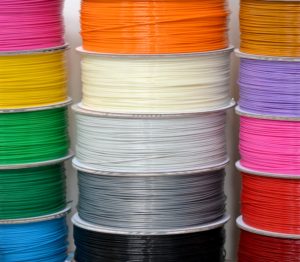New Printer Options
We no longer sell the Markforged line of 3D printers, but we do offer the leading open source material printers from German RapRap, incredible printers from EnvisionTEC, and latest industrial printers from MakerBot. Check them out below.
Additive manufacturing or 3D printing has become commonplace in today’s manufacturing industry. It allows organizations to quickly create parts:
- Using geometries and structures that couldn’t be made using traditional manufacturing methods
- That have incredible strength-to-weight ratios
- At extremely low costs
- That are completely custom, which is particularly important for medical applications
Many organizations are looking towards 3D printing to revolutionize their manufacturing operations, but in order to do it right, organizations must select the right tool that can address their manufacturing needs and provide efficient ROI.
Organizations must consider their current and future needs to successfully select the right 3D printer.
How to Choose a 3D Printer: What to Consider
Picking a 3D printer is not an easy task. You must take numerous things into account when determining the right unit for their organization:
- What are you planning on printing?
- What types of materials do you want to use?
- How strong do your parts need to be?
- Is this printer going to be used just for prototyping or for final end-use parts?
- What kind of software compatibility do you require?
- How fast do you want prints to be completed?
- How precise and what kind of resolution do you want your prints to have?
- Do you want to be able to use parts directly off the printer, or are you okay with having to complete some post-processing?

By taking the time to figure out your current and potential future needs, you will be able to better determine what type of 3D printing method you will want to use and, in turn, what 3D printer will be best suited for you.
Understanding 3D Printing Materials
Various 3D printing materials give you a range of strength, elasticity, and durability. Once you have selected your preferred material, you can then determine what printing processes you want to utilize. Although the possibilities of 3D printing materials are relatively endless, here are some of the more common ones used in manufacturing:
- Thermoplastics: This is the most common material used in additive manufacturing, and its low cost makes it particularly useful for prototyping. Its durability allows it to squish rather than shatter under pressure; however, the low melting point and low chemical and abrasion resistance make this material impractical for functional end-use parts.
- Composites: Composite filaments combine two or more materials to take advantage of the structural benefits of both. They provide high strength-to-weight ratios that can be utilized in a range of engineering applications.
- Photopolymers: These liquid materials transform into a solid structure when exposed to certain light sources. In contrast to thermoplastics, due to the molecular change that occurs during the curing process, photopolymers cannot be melted, but are significantly more brittle and break down after continued light exposure.
- Metal: A newer advance in additive manufacturing, 3D printing metals involve high heat and a lot of power. 3D printed metals often start in a powder form, and different heating techniques are used to fuse the powders together. Once fused, these parts often require some post-processing to strengthen or finish them off.

Understanding 3D Printing Processes
Similar to materials, the 3D printing process used to print parts will have an impact on how the part performs. By understanding your end product goal, you can better determine what material and what process you want to use.
Different 3D printing processes use different materials and provide varying levels of strength, durability, and elasticity.
FFF: Fused Filament Fabrication
FFF is the most common 3D printing technology. It is used with thermoplastic and composite materials. When using thermoplastics, the material is heated, pushed through a nozzle, and laid down layer by layer. Depending on the 3D design, parts can be completely hollow or have low density. This method is typically used for prototyping and modeling.
When used with composite materials, the FFF technique is the same. The composite material fibers are mixed with another thermoplastic medium and laid down layer by layer. By mixing the composite material with the thermoplastic, parts have a smoother finish, increased stiffness, and improved dimensional stability. This increased strength and smooth finish make it possible for these parts to be used right off the printer.
SLS: Selective Laser Sintering
SLS also is used to create parts using thermoplastics. Unlike FFF, thermoplastics used in this additive manufacturing technique start out as powders, then a laser is used to melt and bind the material into the desired shape. On an SLS printer, the print head dispenses a layer of thermoplastic powder over the entire part, then goes over selected locations with the laser for binding. This cross-section layering and lasering gives parts increased strength with isotropic properties.
CFF: Continuous Filament Fabrication
CFF was designed to be a cost-effective solution to creating 3D printed parts that can be used to replace metal parts. It involves laying a continuous strand of filament (carbon fiber, fiberglass, etc.) that is surrounded and cured with a thermoplastic. This mixture of materials provides incredible strength and durability that is similar to metal.
SLA: Stereolithography
SLA is similar to SLS in that it uses a laser to selectively cure specific portions of material that have already been laid down. In contrast, SLA dispenses photopolymers that are already liquefied layer by layer and cures them with the laser. This technique takes advantage of the molecular composition of the material to create parts that are fully dense, isotropic, and have incredible detail.
ADAM: Atomic Diffusion Additive Manufacturing
A new method specifically developed for the Markforged Metal X, ADAM is a revolutionary and efficient method for 3D printing metal. It combines techniques from 3D printing and metal injection molding to create metal parts significantly faster than other methods.

Metal powder encased in plastic is laid down one layer at a time. Once the printing is complete, the entire part is washed to remove the plastic binding, and then sintered in an oven to fuse the metal powders together. This technique is much faster, safer, and more cost effective than other metal 3D printing methods.
SLM: Selective Laser Melting
SLM is the more traditional metal 3D printing method that combines SLS techniques with metal materials. Metal powders are laid down one layer at a time within an inert gas chamber and then selectively fused together using a high-powered laser. Once the parts are sintered, they must go through numerous post-processing steps, like cleaning and removing supports, to be ready for use. Due to the geometric limitations associated with the high heat and part-warping possibilities, SLM is best used for functional metal parts like medical implants.
How to Pick a 3D Printer: Find a Solution Partner
Once you have determined what you want to create, what you want to make it out of, and how you want to make it, you can start looking for a 3D printer to suit your needs. Due to the volume of 3D printers on the market, we recommend finding a solution partner like 3HTi to help you throughout your purchasing journey. Someone who understands the technologies available will be able to best guide you to the right 3D printer for your organization.
Think you know what you need? Check out these other articles about our available manufacturing 3D printers:
- Metal Printing with the Markforged Metal X
- Composite 3D Printing with the Mark Two by Markforged
- The Latest Markforged Printers
- Introducing the Mark X
Or, if you would like some additional guidance on what printer is best for you, contact us.

